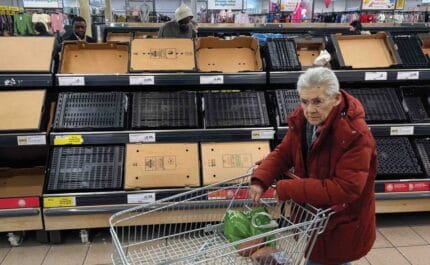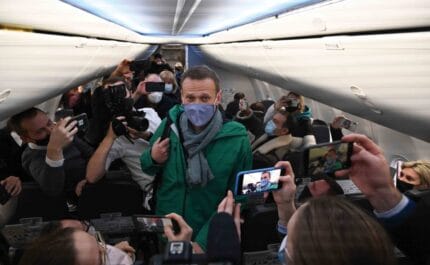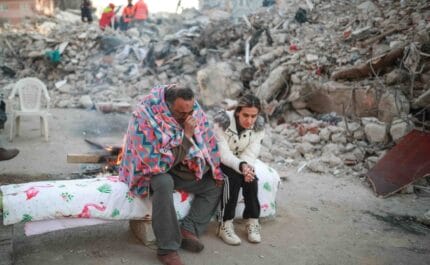Hell’s kitchen
In July 2012, it was reported that 63,000 Somalis had returned to Mogadishu since the Islamist army of al-Shabaab had been thrown out of the capital a year earlier. We told the story of a city reborn and met the man who braved suicide attacks and foreign invasion to launch a restaurant amid the chaos
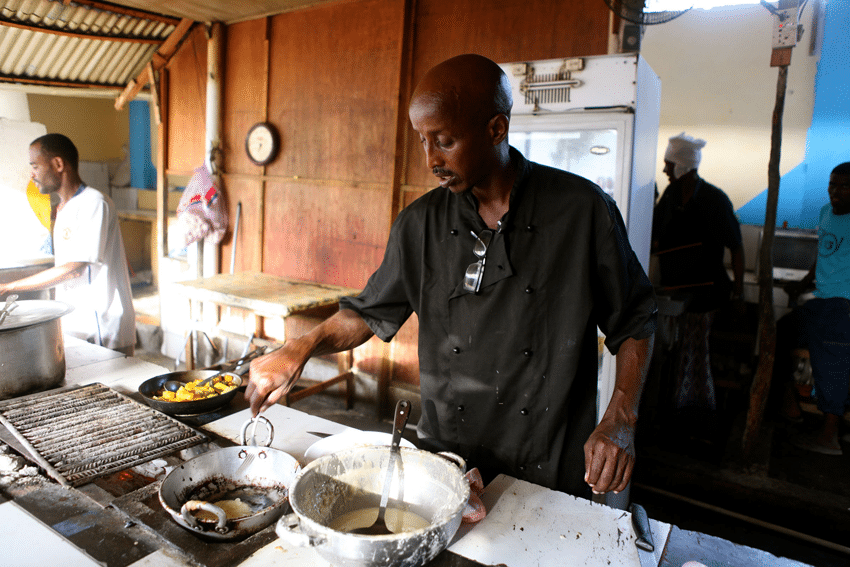
17th July 2012 (Taken from: #8)
For a quarter of a century, as his home city of Mogadishu was engulfed by civil war, Ahmed Jama lived abroad. He had been lucky enough to escape, first to Kenya, then Uganda, then the UK, where he studied catering in Solihull and opened his first restaurant in London, on the Fulham Palace Road.
But having spent much of his life escaping Somalia, in late 2008 Jama returned home. He found a city under the control of Islamist insurgents who fought daily battles against a small force of African Union soldiers based at the airport. Unbowed by the conflict and fuelled with a native son’s optimism, Jama opened his first café in a place that fully deserved its “Most Dangerous City in the World” tag.
“I was scared all the time, but when you have a dream you follow it. I’m trying to show people the place is safe,” he told me one afternoon in summer 2012 as we sat at one of the plastic tables in The Village, a walled restaurant with an open kitchen in a converted villa in the Hodan District of the city.
I was scared all the time, but when you have a dream you follow it. I’m trying to show people the place is safe”
The Village attracts a busy lunchtime crowd and, following an early afternoon lull, a steady trickle of customers builds up to the evening rush. Jama is often to be found in his chef’s uniform, slicing beef and fish, chopping peppers, onions and garlic, manning the spitting skillets of mash-mash – a stickily sweet plump pancake eaten as an appetiser – stir-frying meat and veg in wide pans, or stirring large cauldrons of stew. There is a vintage Italian espresso machine heated by charcoal on the tiled counter and dozens of waiters and cooks wearing branded T-shirts.
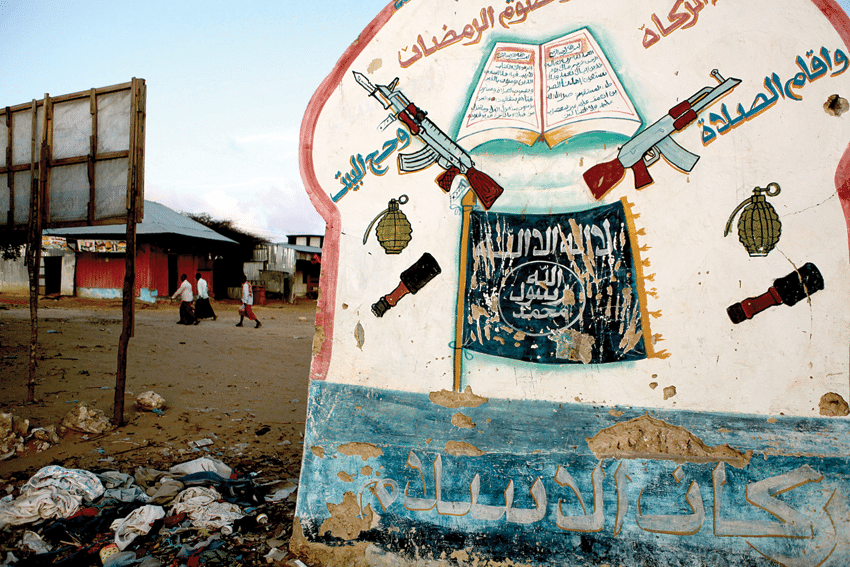
An al-Shabaab mural adorns a wall in Mogadishu
Plates of food sell for $10 each. “You can get any kind of meat in Somalia, any kind of fish and vegetables,” Jama enthused, praising his country’s “organic” produce. Fish is particularly popular, he said, with the catch of the day regularly including shark, swordfish, tuna and lobster. We visited the morning fish market in a warehouse by the seawall to find all of the above laid on the blood-slicked cement floor; a forlorn turtle was also on sale, flipped on its shell and awaiting the fishmonger’s knife.
But Jama’s business empire isn’t limited to The Village. He has other ventures including another restaurant, in the Villa Somalia government district, and when we met he was soon to open a ten-bed hotel on Jazeera Beach, nine miles south of Mogadishu. His next plan was for a guesthouse in the city centre which he hoped to open before the end of the year.
Although Jama spends almost all his time in Mogadishu he still has his Hammersmith restaurant, also called The Village. “The missus, she runs it,” he told me in his bizarre Somali-inflected Cockney-Brummie English. He complained about British taxation, the coalition government and the floundering UK economy, joking, “Right now it looks like it might be better to invest here than in London!”
State of invasion
Somalia was tossed into chaos in 1991 when the last government collapsed in a hail of bullets. The president, Mohamed Siad Barre, a military dictator who had played both sides in the Cold War to amass a staggering array of weaponry that helps sustain the fighting to this day, was chased out by a coalition of clan warlords who quickly turned on one another. The worst of the war was in Mogadishu.

Mogadishu’s old port
By 1993 the country was in the grip of famine and a US-led peacekeeping mission was in town. It mutated into a manhunt and when US Army Rangers were sent to kill the warlord Mohamed Farah Aideed in October that year, two of their Black Hawk helicopters were shot down and 18 American soldiers killed. The twisted remains of one of the helicopters are still here, in a back street near Bakara Market, hidden amongst overgrown prickly pear and bougainvillea bushes.
Respite did not come until 13 years later when a grassroots Islamic movement kicked out the warlords, but its timing, at the height of the “War on Terror”, was poor: Washington saw a terrorist organisation, an al-Qaeda haven in the making, and backed an Ethiopian invasion to oust the Islamic Courts Union. The ICU was defeated and its leaders scattered but its armed wing – al-Shabaab, meaning “The Youth” – fought on, mounting a determined and ultimately successful insurgency against the Ethiopians.
 The Ethiopians were replaced by a small African Union force that has now grown to around 19,000 and has chased out al-Shabaab, bringing a measure of peace to Mogadishu.
The Ethiopians were replaced by a small African Union force that has now grown to around 19,000 and has chased out al-Shabaab, bringing a measure of peace to Mogadishu.
When I first visited the city as a reporter in early 2010, Jama had already opened two restaurants, and although I drove past one of them and saw the busy tables outside there was no way I, as a foreigner, could have gone there. I had to move around town in an armoured truck surrounded by soldiers of the African Union Mission in Somalia (Amisom). They were under siege and had their backs to the ocean, controlling just a few blocks of the capital and enduring daily battles.
Al-Shabaab controlled much of the south of the country and most of the city. A few months earlier a squad of al-Shabaab suicide bombers had driven vehicles laden with explosives into the heart of the Amisom base, killing the deputy commander and 17 soldiers. I squatted on the roof of a building while bullets fired by al-Shabaab snipers smacked into the sandbags in front and the wall behind. I was woken by mortar fire most nights. New civilian casualties, often children, were brought to the city’s hospitals every day. But in August 2011 al-Shabaab retreated from the capital under sustained military pressure from a strengthened Amisom force, supported by the United Nations and paid for by the US and the EU.
The healing of Mogadishu
A year later and the changes are stark. Like pretty much every airport in poor, once war-torn parts of Africa, Mogadishu’s has long featured the carcass of a crashed Russian transport plane, but this summer work teams were deployed to slice it up and carry it away piece by piece.
Inside the terminal building the symbolic clean-up continued. Gone were the old arrival cards asking “make and caliber of weapon” alongside more mundane personal details; in their place were booths with scanners, computers and cameras. Jama was running a Village-branded coffee bar in the new departure lounge.
In town, shop fronts were freshly painted with murals advertising their wares and services: garish naive images of teeth and toothbrushes for a dentist, pills and syringes for a pharmacy, crank shafts and spark plugs for a spare parts store.
Construction sites were swallowing up multistorey buildings that had been concertinaed to the ground by years of heavy machine gun, rocket and mortar fire. Exoskeletons of rickety wooden scaffolding had formed around others that had lost their outer walls years earlier, leaving them standing like giant honeycombs.
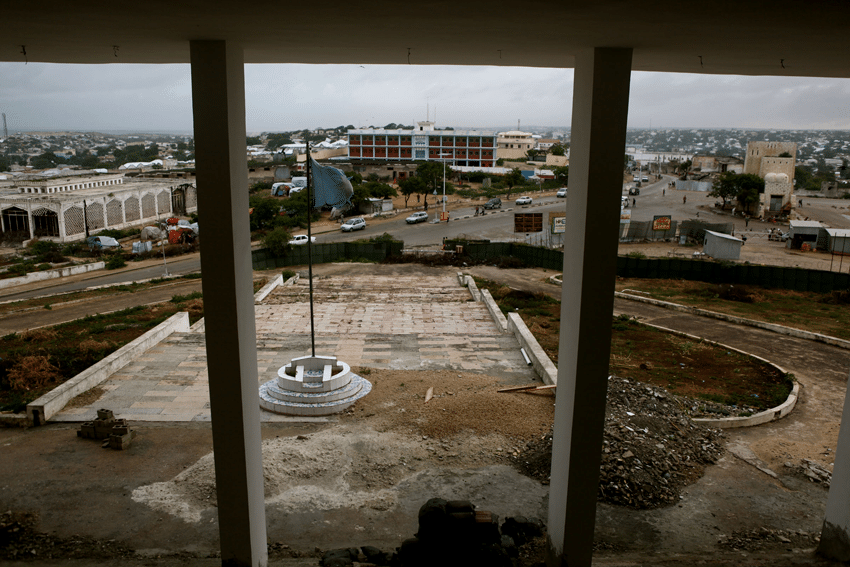
A view from the Parliament which was under refurbishment after being bombed out
Traffic filled the formerly abandoned streets, tea shop owners arrayed their chairs and tables below shady trees and solar-powered streetlights lined the central reservation while fairy lights adorning a newly painted plinth on a roundabout flashed redundantly in the sun.
The bullet-scarred building on whose roof I had crouched a couple of years before was fixed up, painted salmon pink with blue mirrored windows. Over the last two decades the fighting in Mogadishu had been so feverish and sustained that it was hard to find a square foot of wall not flecked with bullet holes. Where these had been filled in with plaster the walls were like huge Rorschach tests.
A building that had served as a billet for AU troops was now my hotel. The soldiers had slept on thin mattresses on the floor, their washing hanging from strings above their heads, tins of bullets stacked in the corner by their assault rifles. On the flat roof were machine gun nests that were manned 24 hours a day.
As I checked in to its new incarnation I realised I had been here before. The centre of my room boasted an absurdly grand curving archway, serving no discernible purpose. A couple of years earlier I had idly kicked pieces of rubble beneath this archway, staying clear of the sandbagged windows, sweating in my helmet and flak jacket as I waited to interview a military officer.
The future of the city
The absence of outright warfare between al-Shabaab and Amisom has made Mogadishu immeasurably safer, at least for ordinary Somalis who are today far less likely to die a random, violent death. Foreigners still need armed guards to protect against both jihadists and kidnappers. Gunshots crack day and night, there are suicide attacks and homemade car bombs and roadside bombs explode or are defused regularly. Government and security officials are still targeted for assassination and there is a pervasive violent criminality borne of years of chaos, impunity and the sure knowledge that a gun means power.
Mogadishu has plumbed the depths of self-inflicted misery and stood as a blasted monument to mankind’s capacity for destruction, so even this state of affairs is a huge improvement and reason for celebration. Yet residents like Jama know from experience the dangers the city still poses.
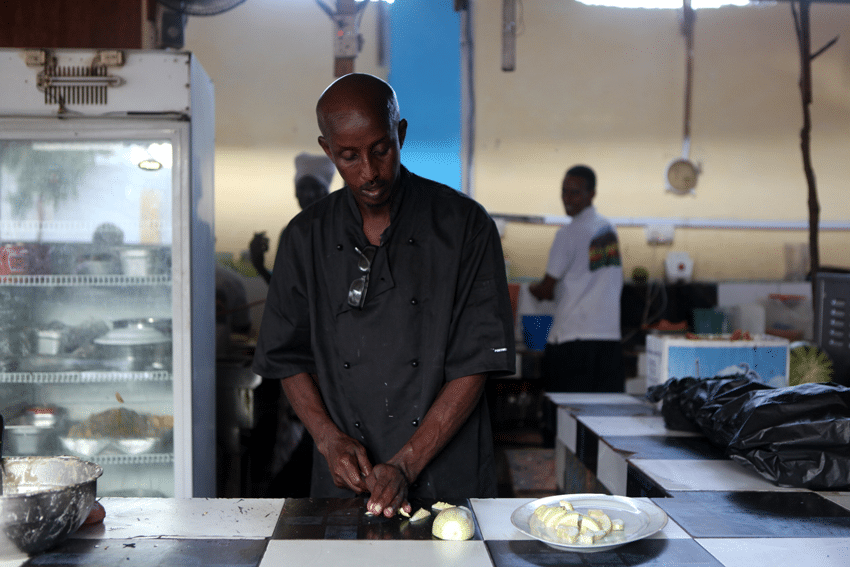
In April 2012 he was at Somalia’s National Theatre, whose opening a couple of weeks before was meant to symbolise the city’s rebirth and the revival of traditional pastimes of music and poetry. Instead it was turned into a bloodbath when a female suicide bomber blew herself up, killing at least ten people.
Mogadishu has plumbed the depths of self-inflicted misery and stood as a blasted monument to mankind’s capacity for destruction”
Jama was just a few seats away when the explosive vest detonated, and a piece of shrapnel sliced across his face, leaving a scar half an inch from his right eye. Typically resilient, he refused to let the incident dent his determination to be part of the positive changes happening in the city. “People are tired of war, they want jobs,” he said. “You need to take a risk. We can make this a beautiful country again.”
When I met city mayor Mohamed Nur in his office in the Hamar Weyne District he echoed Jama’s feeling. “Mogadishu was one of the best, most beautiful cities in Africa, very clean, very peaceful,” he told me. Like Jama, he had lived in Britain for years before returning to his home city in 2010. Nur talked of the nightclubs, restaurants and bars of his youth, but most of all he talked of Lido Beach, once the beating heart of the capital’s social scene.
After years of being off limits as the frontlines shifted and the fighting tore relentlessly on, Lido Beach is gaining in popularity once more. The hollowed shells of bombed-out villas and restaurants line the shore, their ragged shadows stretching across the sand as the sun sets. But the beach bears none of these scars of war: on Friday afternoons couples and families promenade, children splash in the shallows and teenage boys play football as waves break on the distant reef and lap at the shore.
People are tired of war, they want jobs. You need to take a risk. We can make this a beautiful country again”
Most of the beachgoers are diaspora Somalis recently returned home, like Jama. They are visiting relatives, scouting for business opportunities or reclaiming properties. I met Fatima Ahmed, a Somali visiting from Stockwell in south London, as she walked along the city’s seafront with her three children. It would be her first Ramadan with her family for more than 20 years. “Now is so much better than before,” she said. “We used to live close to here, near the sea. In the future, soon I hope, we want to move back to Mogadishu.”
But the city’s security still has a long way to go. In September another suicide attack targeted Jama’s restaurant near the government quarter, killing 14 including five of his staff. Yet another occurred in early November, killing a security guard. Despite the shocks, Jama insists he will not leave. “What can I do?” he says, defiant. “I am still here, still standing. I will not be scared off.”
Slow Journalism in your inbox, plus infographics, offers and more: sign up for the free DG newsletter. Sign me up
Thanks for signing up.
